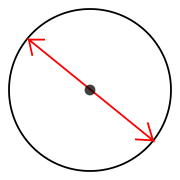diameter
The diameter ( Greek διάμετρος diámetros ) of a circle or a sphere is the greatest possible distance between two points on the circle or the surface of the sphere. In the case of a circle, this is the longest possible chord . The diameter of a body of revolution is the longest chord perpendicular to the body's axis of rotation.
geometry
The diameter of a circle or sphere corresponds to the distance between the points of intersection with a straight line that runs through the center point. Even in higher-dimensional cases, the diameter is the length of the line that is cut from a straight line through the center of the sphere (the circle, the sphere, the sphere ...). This distance itself is also sometimes referred to as a diameter of the sphere.
Half of a diameter is called a radius . The ratio of the circumference of a circle to the diameter is the number of circles and therefore applies to a circle
- .
Inside and outside diameter
In the case of a circular ring or a hollow cylinder, a distinction is made between the inner and outer diameter, called the inner and outer diameter.
Different symbols are usually used to differentiate, e.g. B. , or for the inner and , or for the outer diameter.
The inner and outer radius are referred to analogously . The difference between the outer and inner radius is called the ring width for circular rings and the wall thickness for hollow bodies .
Diameter in metric spaces
A mathematical generalization is the diameter of a set in a metric space . It is defined as the supremum of all distances between two points in space,
For circles and spheres in Euclidean spaces , this definition agrees with the geometrical term mentioned above.
technology
Technical formulas are preferably structured in such a way that the diameter and not the radius is included as a variable, since the diameter can be determined directly with the measuring equipment customary in the workshop (e.g. caliper ) and then used in the formula.
In technical drawings and texts, the diameter symbol ⌀ (U + 2300) is placed in front of the dimensions of circular shapes. In the past, this symbol was only used when the circular shape was not immediately recognizable, i.e. H. for example in the sectional representation of holes or through holes . According to DIN 406-11 from 1992, the diameter symbol must always be put in front since then.
Examples of hollow bodies with inner and outer diameters are washers , hoses , tubes , hollow shafts and roller bearings . In the case of pipes and hoses, the standardized inside diameter is called the nominal width . The term nominal diameter is used for inside or outside diameter depending on the industry.
Measurement method
Various measuring methods are suitable for measuring and testing diameters, depending on the size . Both inside and outside diameters can be measured with micrometers and calipers .
Larger diameters can also be measured using coordinate measuring machines. Optical measuring methods such as laser micrometers are suitable for small diameters in the micrometer range .
Limit gauges can be used to check the diameters of a workpiece .
Other uses of the term
- Diameter (graph theory) - the maximum distance between two nodes in a graph
-
Equivalent diameter - the diameter of a sphere equivalent to a given body
- Aerodynamic diameter - equivalent diameter in terms of aerodynamics
- Biparietal diameter - the transverse diameter of the child's head in the womb
- Ideal critical diameter - a parameter in steel production
- Conjugate diameters - diameters associated with each other for conic sections




















